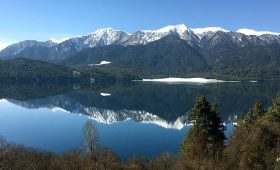Shuklaphanta National Park was established in 1976. It was known as Royal Shuklaphanta Wildlife Reserve. This national Park is one of the critical wildlife habitats in Nepal. Shuklaphanta National park is the youngest national park of Nepal. It was hunting area at the beginning. It was established with primary objective to conserve swamp deer. The area was favorite hunting ground of Nepal’s ruling class. The name of Shuklaphanta was derived from the grass found in the protected area. The jungle of this region was once the site of the ancient kingdom. Although the area of the Reserve is small, it supports a wide range of biodiversity which is nationally and globally important.
Location of Shuklaphanta National Park
Shuklaphanta national park lies in the extreme south western section. Recently, it’s in province no.7. Shuklaphanta is on Nepal’s Terai in Kanchanpur district. The reserve shares a common boundary with the Indian state of Uttar Pradesh in the south and west which is form by the Mahakali River, and a major tributary of the Ganges. It is border on the eastern side by the Chaudhar River and to the north by a forest belt and cultivations. It covers an area of 305 square km. The area of buffer zone is 243.5 square km.
Flora and Fauna
24 species of mammals, 350 species of birds and 10 species of another animals are found in the national park. The vegetation types primarily include Sal forest, Sal savanna, etc. They are part of natual gifts between climax forest and grassland that is maintain by fire and floods. The National Park have large numbers of Bengal Floricans and swamp deer.
Some 54.7% of the reserve is cover by mixed deciduous forest, grassland and marsh in the south-west where soils are of recent alluvium. The rest is moist deciduous forest and savanna, supported by the better drained soils.
There are 700 species of flora, 553 vascular plants, 410 dicots, 125 monocots. In the rivers and ponds/lake 28 species of fish and 12 reptiles are record.
Climate
The months of December and January are fairly cold and misty with occasional frost. The monthly minimum temperature varies from 10 to 12 o C in winter.It rises to 17oc in the spring and 26oCin the summer. Over 90% of the annual precipitation fall in monsoon between June and September. In February and March ,the maximum temperature rises up to 22o to 25ocC. The relative humidity remains fairly high throughout the the year except in the dry months of the pre-monsoon period.
Best Time to Visit
The best time to visit Bardia National Park and Shuklaphanta National Park is from mid September to mid December and the start of February to the end of May.
How to Reach Shuklaphanta National Park?
Daily basis Flights are accessible from different transportation. Bus/jeep/train are available too. The distance between kathmandu and Shuklaphanta national park is 305 square km.
It takes around 22 hr 55 min to reach Shuklaphanta region from kathmandu by bus/jeep.
Activity in Shuklaphanta National Park
There are sevreal activities which can be perform in Shuklaphanta national park. You can enjoy and spend you days happiky in national park. Some of the major activities inside the park availabe are as below:
- wildlife experience
- bird watching
- trekking
- rafting
- village tour experience
- pilgrimage




